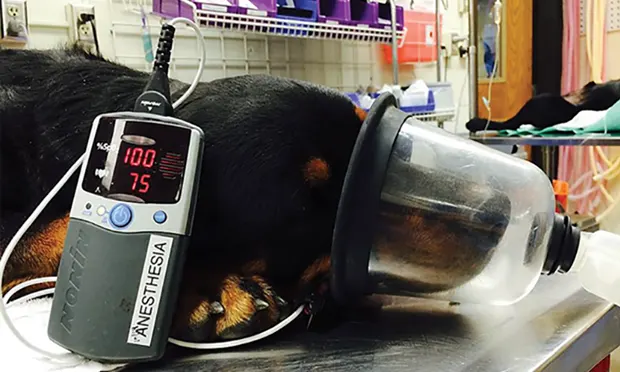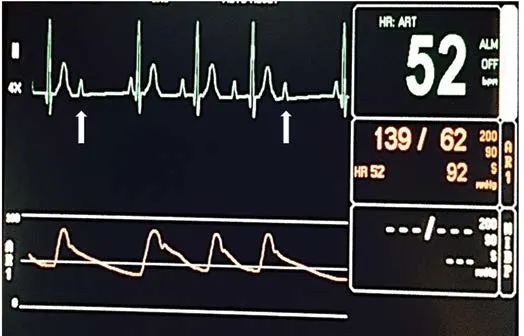Dexmedetomidine & Atipamezole in Dogs & Cats
Rebecca A. Johnson, DVM, PhD, DACVAA, University of Wisconsin
Martin J. Kennedy, DVM, University of Wisconsin
Dexmedetomidine is an α2-agonist that produces varying degrees of sedation, muscle relaxation, and analgesia. The duration of sedation is approximately 1 to 3 hours when administered at the recommended IM or IV doses (1-10 µg/kg), with IM administration providing longer periods of sedation. These effects are reversed by the α2-antagonist atipamezole (0.1-0.3 mg/kg IM), which is available in a 5 mg/mL formulation (Antisedan).
Dexmedetomidine
Indications
Dexmedetomidine is approved for use in dogs and cats to facilitate physical examination, minor clinical procedures, and as a preanesthetic medication. Dexmedetomidine is also used to provide sedation during emergence delirium from general anesthesia. Constant rate infusions of dexmedetomidine (0.5-3.0 µg/kg/h IV) can also provide prolonged sedation for anxious or disorderly inpatients.1
Contraindications & Drug Interactions
Dexmedetomidine should, in general, be reserved for young, healthy patients. Dexmedetomidine has significant negative cardiovascular effects (see Advantages & Disadvantages) and is contraindicated in any patient suffering from or having a predilection for cardiovascular disease. There is argument, however, that dexmedetomidine may be beneficial in cats with hypertrophic cardiomyopathy (HCM) showing dynamic left ventricular outflow tract (LVOT) obstruction, where the increase in systemic vascular resistance and decrease in heart rate produced by α2-agonists may actually eliminate the LVOT obstruction.2 Dexmedetomidine is also contraindicated in patients suffering from respiratory disorders, liver disease, kidney disease, shock, severe debilitation, or stress caused by extreme heat, cold, or fatigue.3 The medication can produce vomiting in dogs and cats following IM administration, so it is also contraindicated when vomiting could be significantly detrimental to the patient (eg, increased intraocular pressure, increased intracranial pressure, increased intragastric pressure). Because α2-agonists reduce uterine blood flow and may affect intrauterine pressure, dexmedetomidine is not recommended for use in pregnant animals.
Because of its sedative and analgesic properties, dexmedetomidine can potentiate the effects of other sedatives, induction agents, inhalant anesthetics, and opioids. Administered alone, α2-agonists produce minimal respiratory effects in healthy dogs and cats, characterized by a decrease or no change in respiratory rate and minimal change in blood gas tension.4 Nonetheless, significant hypoventilation resulting in hypoxia can occur when α2-agonists are administered with other drugs (eg, opioids, ketamine, propofol), so oxygen supplementation is recommended when dexmedetomidine is administered with other drugs (Figure 1).5 Supplemental oxygen may prevent hypoxemia but will not prevent respiratory acidosis. Premedication with dexmedetomidine can reduce the amount of anesthetic induction drug required by approximately 30% to 60% and the inhalant anesthetic requirements by approximately 35% to 90%, depending on dose.3,5 With this in mind, anesthetic induction and maintenance drugs should always be titrated to effect, and patients should be closely monitored throughout the procedure.

Figure 1 Oxygen supplementation via face mask to a dog following dexmedetomidine sedation. Hemoglobin saturation, read from the pulse oximeter placed on the lip, is 100% and heart rate is 75 beats per minute.
Administration of dexmedetomidine results in increased systemic vascular resistance, bradycardia, and a marked decrease in cardiac output.6 The initial decrease in heart rate is a reflex bradycardia caused by the increase in systemic vascular resistance. The use of anticholinergics before or after administration of dexmedetomidine is controversial. Treatment with anticholinergics before administration of dexmedetomidine prevents bradycardia; however, cardiac output can still be decreased by over 50%, despite normalization of heart rate.6 Administering an anticholinergic after dexmedetomidine administration increases the risk of dysrhythmias; thus, routine use of anticholinergics concurrently or after treatment with dexmedetomidine is not recommended.3 If a patient has profound bradycardia (ie, heart rate <40 beats per minute for dogs, <100 beats per minute for cats) following administration of dexmedetomidine, an electrocardiogram should be evaluated to assess rhythm and, if ventricular escape beats are present, atipamezole should be administered.
Advantages & Disadvantages
Dexmedetomidine produces profound sedation and muscle relaxation that facilitates examination, IV catheter placement, diagnostic procedures, and minor surgical procedures (eg, laceration repair, small tissue biopsy). Analgesia provided by α2-agonists has been shown to be synergistic with opioids.7 In addition, premedication with α2-agonists attenuates the stress response elicited by surgery.8,9 The 0.5 mg/mL formulation of dexmedetomidine also allows for smaller volumes to be injected IM, which may be easier to administer to fractious or less cooperative patients.
Dexmedetomidine has a relatively short duration of action, with sedation lasting from 1-3 hours in dogs and cats at the recommended doses, making it ideal for short procedures or when a patient needs to be discharged on the same day as the procedure. Another advantage of dexmedetomidine is that in the event of complications or excessive sedation, its effects can be reversed by atipamezole administration.
The major disadvantage of dexmedetomidine is its cardiovascular effects, limiting its use to young, healthy patients (American Society of Anesthesiologists [ASA] classification status I and II). Even small doses of α2-agonists (approximately 1 µg/kg) can decrease cardiac output by approximately 50%.10 The administration of α2-agonists commonly results in a biphasic blood pressure response; initially the patient is bradycardic with elevated blood pressure, but with time the systemic vascular resistance may decrease, resulting in hypotension with continued bradycardia.11 In addition to bradycardia, a variety of dysrhythmias may be observed, including second-degree atrioventricular (AV) block, third-degree AV block, supraventricular or ventricular tachycardia, supraventricular or ventricular precontractions, and ventricular or junctional escape beats (Figure 2).

Figure 2 Second-degree AV block in a dog following dexmedetomidine administration. There are multiple P waves on the electrocardiogram that do not have associated QRS complexes (arrows). Heart rate is 52 beats per minute.
Cost
Although the cost of dexmedetomidine may be more than for other sedatives (eg, acepromazine), the reduced amount of induction and maintenance drugs required for anesthesia is likely to offset any additional cost incurred by dexmedetomidine use.
Atipamezole
Indications
Atipamezole reverses the sedative, analgesic, and cardiovascular effects of dexmedetomidine. Atipamezole is approved for IM administration in dogs; it has also been used successfully off-label in cats.12 Atipamezole is typically administered after completion of a minor procedure performed under dexmedetomidine sedation. When dexmedetomidine has been used for premedication, atipamezole can be administered during anesthesia to treat excessive bradycardia and dysrhythmias, or it can be administered after anesthesia if recovery is prolonged. Atipamezole is also indicated during cardiopulmonary resuscitation when the patient has received dexmedetomidine; in this circumstance, it can be administered IV (0.1 mg/kg).13
Contraindications & Drug Interactions
IV administration of atipamezole is usually contraindicated, except for emergency situations. Atipamezole administered IV may result in rapid relaxation of vascular tone, which coupled with bradycardia could result in cardiovascular collapse.11 Atipamezole is also formulated with the preservative methylparaben, which can cause histamine release leading to hypotension. It has been recommended that atipamezole and anticholinergics not be used concurrently, as both can cause significant increases in heart rate.14
Advantages & Disadvantages
The major advantage of atipamezole is that it can rapidlyreverse the sedative and cardiovascular effects of dexmedetomidine, and cardiac output is returned to baseline levels following administration.6 Atipamezole is highly selective for the α2-receptor and does not have some of the adverse effects associated with less selective α2-antagonists (eg, tolazoline, yohimbine). Atipamezole also has a wide safety margin when administered IM.11
Atipamezole is approved only for IM use, as IV administration of α2-antagonists can result in hypotension, tachycardia, or even cardiovascular collapse. Another disadvantage is that all analgesia and sedation provided by dexmedetomidine will be reversed by atipamezole. Appropriate analgesia (ie, opioids) should be provided for painful procedures; this will help reduce the dose of dexmedetomidine and provide additional pain control if atipamazole is administered.
In addition, there is the potential for resedation from the initial dose of α2-agonist approximately 30 to 60 minutes after atipamezole because of its short duration of action.
Cost
Any additional cost associated with atipamezole can be easily justified by its ability to reverse the negative cardiovascular effects of dexmedetomidine. Atipamezole can minimize the time that patients experience significant cardiovascular depression.
Conclusion
Dexmedetomidine and atipamezole are useful in many veterinary situations involving healthy dogs and cats requiring sedation, muscle relaxation, and analgesia. However, selection should be on an individual patient basis as dexmedetomidine is associated with significant negative cardiovascular effects.
Editor's note: This article was originally published in August 2015 as "Dexmedetomidine & Atipamezole"